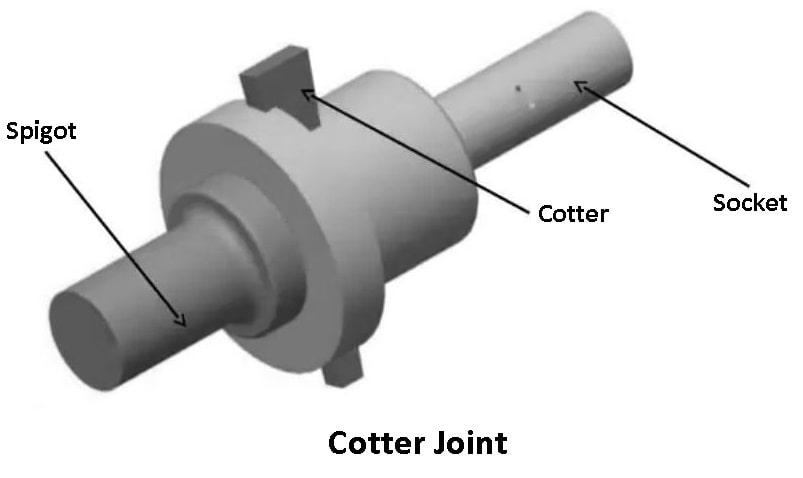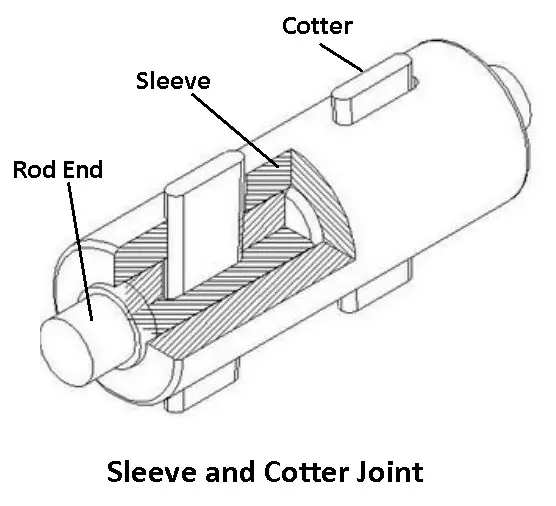In this article, you’ll learn what is cotter joint? Its design, parts, types, applications, and the difference between the cotter joint and knuckle joint. Also, you can download the PDF file at the end of this article.
What is Cotter Joint?
The cotter joint is a process of temporarily attaching two coaxial rods. In which, one rod is fitted with a spigot that goes inside a socket on one end of the other end.
The socket has slots, and the spigot is aligned so that a cotter can be inserted to lock the two rods together. These joints are also known as socket joints and spigot joints. The purpose of using this joint is to support axial loads between two rods, which may be tensile or compressive loads.
This joint opposes the rotation of one rod relative to another. It is therefore not used to joint a rotating shaft. This is because the cotter will not be balanced and may work loose under vibration and centrifugal force.
Read Also: What is the function of a Knuckle Joint? [Parts & Applications]
Parts of Cotter Joint
- Spigot
- Socket
- Cotter

1. Spigot
The spigot consists of a rectangular slot for passing the cotter. It has a collar that rests on the end of the socket. It is known as the male part of the cotter joint.
2. Socket
The socket consists of a rectangular slot to pass the cotter through it. They have a circular hole in which the spigot fits. It is known as the female part of the cotter joint.
3. Cotter
Cotter is a metal of flat wedge-shaped piece, which s used to connect two rods that transfer force without rotation. This transferred force is probably tensile or compressive. The cotter is fitted into a tapered slot and is held in position by wedge action. This is due to the taper on the cotter.
In general, the taper on the cotter provides two benefits: Firstly, this taper is easy to remove, and the joint is easy to disassemble. Second, it ensures the tightness of the joints and prevents the parts from loosening.
Read Also: Types of Universal Joint: Parts, Working & Uses
Types of Cotter Joint
- Socket and spigot cotter joint
- Sleeve and cotter joint
- Gib and cotter joint
1. Socket and Spigot Cotter Joint
These are types of cotter joints in which one end of the rod is provided by a socket, and another end of the other rod is inserted into the socket. The end of the rod goes into the socket known as a spigot. A rectangular hole is formed in the socket with a spigot.
The cotter is then driven across a hole to create a passing connection between the two rods. In this joint, the load is acting axially but reverses its direction. Thus, this joint carries the tensile and compressive loads equally. The collar on the spigot lifts the compressive load.
2. Sleeve and Cotter Joint

The sleeve and cotter joint is a type of cotter joint used to connect two coaxial cylindrical rods. It consists of one sleeve and two wedge-shaped tapered cotters. This slot has a cotter mount cut into a sleeve and cylindrical rod.
In this joint, the taper is approximately 1 in 24, and it may be noted that the taper sides of the two cotters should be facing each other. The clearance is set so that when the cotters are inserted into the two rods, they come close to each other, thus tightening the joint.
Sleeve and cotter joints are simple and rigid enough to carry tensile and compressive force. They can be easily assembled and dismantled. These are also used to connect two pipes or tubes.
3. Gib and Cotter Joint

This type of cotter joint is used where the strap end or larger end of a connecting rod is attached. In some cases, the cotter is driven independently without a gib. Due to this, friction between the ends and the inside slots in straps causes the sides of the strap to open outwards.
To avoid this, gibs are used, which keep the ends of the strap together. In addition, due to the increased holding power, the gibs provide a more excellent bearing surface for the cotter to slide on. Hence, the movement of the cotter slides backward due to less friction. Gib enables parallel holes to be used as well.
Read Also: Function of Woodruff Key: Types, Advantages & Uses
Failure of Cotter Joint
When the cotter joint is tightened into the socket and spigot slot, it is subjected to shear stress. In this way, the cutter breaks or bends at some point when the cutter is loose. Following are the various modes of failure in the cotter joint,
- It is due to the failure of rods in tension.
- Due to the failure of the spigot under tension in the weakest section.
- It occurs due to the failure of the rod or cotter in crushing.
- Because of the failure of the socket under tension in the slot.
- Due to the failure of cotter in shear stress.
- Failure of the socket collar in crushing stress.
- It is because of the socket end and rod end failure under shear stress.
- Due to the failure of the spigot collar under crushing or shear stress.
- Because of the failure of the cotter in bending stress.
Difference Between Cotter Joint and Knuckle Joint
Following are the main difference between the cotter joint and knuckle joint:
| Cotter Joint | knuckle Joint |
| The cotter joint can work both in tensile and compressive load. | Whereas the knuckle joint can work only in tensile load. |
| The Cotter joint cannot allow angular momentum. | Compared to the knuckle joint, it can allow angular movement between rods. |
| These are not subjected to bearing failure. | These are subjected to bearing failure. |
| The cotter joint has a taper in the cotter, and clearance is provided. | In the knuckle joint, there is no taper, and clearance is provided. |
| Cotter joints are used in cotter foundation bolts, joining two rods with a pipe, and for joining piston rods with a c/s head. | Knuckle joint is used in tie bar, links off bicycle chain, joint for rail shifting mechanism. |
Read Also: Different Types of Pulleys and Their Functions [PDF]
Advantages
- These are easy to make, and the parts remain in the same relative position after reassembly.
- Using this type of joint, you can quickly join two rods. It may be a pipe or a tube.
- The Assembling and dismantling of parts of cotter joints are quick and easy. They do not require any force.
- These are simple to manufacture and are readily available for purchase.
- They are pretty rigid and can carry both tensile and compressive loads.
Disadvantages
- Using this joint, you cannot connect rectangular rods and unequal cylindrical rods.
- Sleeve and cotter joints are cannot be used to connect cylindrical members undergoing rotation.
Checkout: What are the different Types of Fasteners & Their Uses
Applications of Cotter Joint
A coaxial joint is used to hold the axial load between two rods, which are tensile and compressive loads. They connect piston rods with a crosshead in a steam engine. These joints are used to connect the piston rod to its extension.
In addition, they connect the pedals to the sprocket wheels in a bicycle. These joints are mounted between the slide spindle and the fork of the valve mechanism. Also, cotter and dowel arrangement for joining the two halves of a flywheel.
Primarily, cotter joints connect the tail rod with the piston rod of the wet air pump. They are also employed to join two rods of equal diameter subjected to axial forces. Cotter joints have been used in steam engines and pump to connect connecting rods to drain mines.
FAQ
The sleeve and cotter joint is used to connect two coaxial cylindrical rods. It consists of one sleeve and two wedge-shaped tapered cotters. This slot has a cotter mount and is cut into a sleeve and cylindrical rod.
In some cases, the cotter is driven alone, that is, without a gib. Due to this, friction between the ends and the inside slots in straps causes the sides of the strap to open outwards. To avoid this, gibs are used, which keep the ends of the strap together.
Wrapping It Up
As I said, it is a method of temporarily joining two coaxial rods. They are rigid in construction and capable of carrying both tensile and compressive loads. They are used to connect piston rods in a crosshead in a steam engine.
I hope I have covered everything about this article. If I missed something, or if you have any doubts, let me know in the comments. If you liked this article, please share it with your friends.
Want free PDFs direct to your inbox? Then subscribe to our newsletter.
Download PDF of this article:
Read more in our blog: